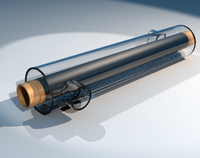
Leidenfrost drops on micro/nanostructured surfaces
Sign Up to like & getrecommendations! Published in 2018 at "Frontiers in Energy"
DOI: 10.1007/s11708-018-0541-7
Abstract: In the Leidenfrost state, the liquid drop is levitated above a hot solid surface by a vapor layer generated via evaporation from the drop. The vapor layer thermally insulates the drop from the heating surface,… read more here.
Keywords: leidenfrost drops; nanostructured surfaces; micro nanostructured; drops micro ... See more keywords

Heat transfer enhancement associated with electrostatic suppression of Leidenfrost droplets
Sign Up to like & getrecommendations! Published in 2020 at "International Journal of Heat and Mass Transfer"
DOI: 10.1016/j.ijheatmasstransfer.2019.119207
Abstract: Abstract A liquid drop levitates on its own vapor on a sufficiently hot surface (the Leidenfrost effect). Application of an electrical potential difference across the vapor gap suppresses the Leidenfrost state via electrostatic attraction of… read more here.
Keywords: suppression; leidenfrost; heat transfer; heat ... See more keywords

Electrostatic suppression of the Leidenfrost state using AC electric fields
Sign Up to like & getrecommendations! Published in 2017 at "Applied Physics Letters"
DOI: 10.1063/1.4999174
Abstract: The formation of a vapor layer at the solid-liquid interface at high temperatures (Leidenfrost phenomenon) degrades heat transfer substantially. Application of an electric field in this vapor layer can fundamentally eliminate the Leidenfrost state by… read more here.
Keywords: leidenfrost; electrostatic suppression; leidenfrost state; electric fields ... See more keywords

The cold Leidenfrost regime
Sign Up to like & getrecommendations! Published in 2019 at "Science Advances"
DOI: 10.1126/sciadv.aaw0304
Abstract: Leidenfrost drops, known to levitate on very hot solids, exhibit a “cold” regime on superhydrophobic solids. Superhydrophobicity (observed at room temperature) and Leidenfrost phenomenon (observed on very hot solids) are classical examples of nonwetting surfaces.… read more here.
Keywords: temperature; cold leidenfrost; water; leidenfrost ... See more keywords